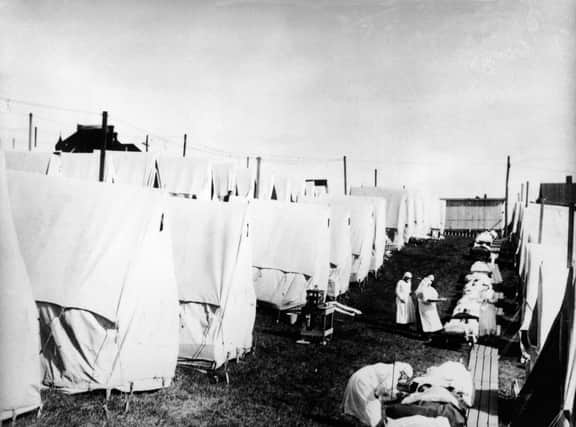Here's what a 'pandemic' means, and when the last ones were before coronavirus


Covid-19 - the coronavirus sweeping the globe - has recently been classified a pandemic by the World Health Organisation (WHO).
"We have called every day for countries to take urgent and aggressive action. We have rung the alarm bell loud and clear," said Tedros Adhanom Ghebreyesus, the WHO chief.
Advertisement
Hide AdAdvertisement
Hide Ad"All countries can still change the course of this pandemic. If countries detect, test, treat, isolate, trace and mobilise their people in the response," he said.
A viral outbreak could be categorised as a pandemic if it is markedly different from recently circulating strains, and if humans have little or no immunity to it, according to the UK’s Health and Safety Executive.
When was the last pandemic?
Before we get to what the 'last' pandemic was, you may be surprised to know that there is actually a pandemic other than coronavirus ongoing right now.
AIDS is currently classed as a pandemic by the WHO, with infection rates as high as 25% in southern and eastern Africa.
Advertisement
Hide AdAdvertisement
Hide AdIn 2006, the HIV prevalence rate among pregnant women in South Africa was 29%.
Effective education about safer sexual practices and blood-borne infection precautions training have helped to slow down infection rates, but the disease's status remains.
Before coronavirus, the last pandemic to grip the world was that of the 2009 flu pandemic, more commonly known as "swine flu".
It is estimated that 11 – 21% of the global population contracted swine flu, though the fatality rate was relatively low, at about 0.01 - 0.08 per cent.
Advertisement
Hide AdAdvertisement
Hide AdBetween 150,000 and 575,000 people were thought to have died.
Previous pandemics in history
Pandemics are nothing new, and even before the mass transit of the world's population through air travel, poor hygiene technologies in even developed countries led to mass outbreaks of disease.
Cholera is one such disease, which has seen multiple pandemics throughout history. The first began in 1817 on the Indian subcontinent, spreading across India by 1820, and claiming the lives of 10,000 British troops stationed there.
Cholera's outbreak have mainly kept to the Indian subcontinent (between 1817 and 1860 it is estimated that 15 million persons died there), although there have been pandemics in both Europe and North America.
Advertisement
Hide AdAdvertisement
Hide AdSpanish flu is perhaps the deadliest pandemic in relatively recent history. From 1918 to 1920 it infected 500 million people around the world, including people on remote Pacific islands and in the Arctic.
50 to 100 million people are thought to have died from the strain - that's more people than were killed in World War I - which had an unusually high mortality rate for young adults.
Of course, the most famous pandemic is that of the Black Plague, which between 1331 to 1353 killed an estimated at 75 million people.
Coronavirus: the facts
What is coronavirus?
COVID-19 is a respiratory illness that can affect lungs and airways. It is caused by a virus called coronavirus.
What caused coronavirus?
Advertisement
Hide AdAdvertisement
Hide AdThe outbreak started in Wuhan in China in December 2019 and it is thought that the virus, like others of its kind, has come from animals.
How is it spread?
As this is such a new illness, experts still aren’t sure how it is spread. But similar viruses are spread in cough droplets. Therefore covering your nose and mouth when sneezing and coughing, and disposing of used tissues straight away is advised. Viruses like coronavirus cannot live outside the body for very long.
What are the symptoms?
The NHS states that the symptoms are: a dry cough, high temperature and shortness of breath - but these symptoms do not necessarily mean you have the illness. Look out for flu-like symptoms, such as aches and pains, nasal congestion, runny nose and a sore throat. It’s important to remember that some people may become infected but won’t develop any symptoms or feel unwell.
What precautions can be taken?
Washing your hands with soap and water thoroughly. The NHS also advises to cover your mouth and nose with a tissue or your sleeve (not your hands) when you cough or sneeze; put used tissues in the bin immediately and try to avoid close contact with people who are unwell. Also avoiding touching eyes, nose and mouth unless your hands are clean.
Should I avoid public places?
Advertisement
Hide AdAdvertisement
Hide AdMost people who feel well can continue to go to work, school and public places and should only stay at home and self isolate if advised by a medical professional or the coronavirus service.
What should I do if I feel unwell?
Don’t go to your GP but instead call NHS 111 or look online at the coronavirus service that can tell you if you need medical help and what to do next.
When to call NHS 111
NHS 111 should be used if you feel unwell with coronavirus symptoms, have been in a country with a high risk of coronavirus in the last 14 days or if you have been in close contact with someone with the virus.
Sources: World Health Organisation and NHS